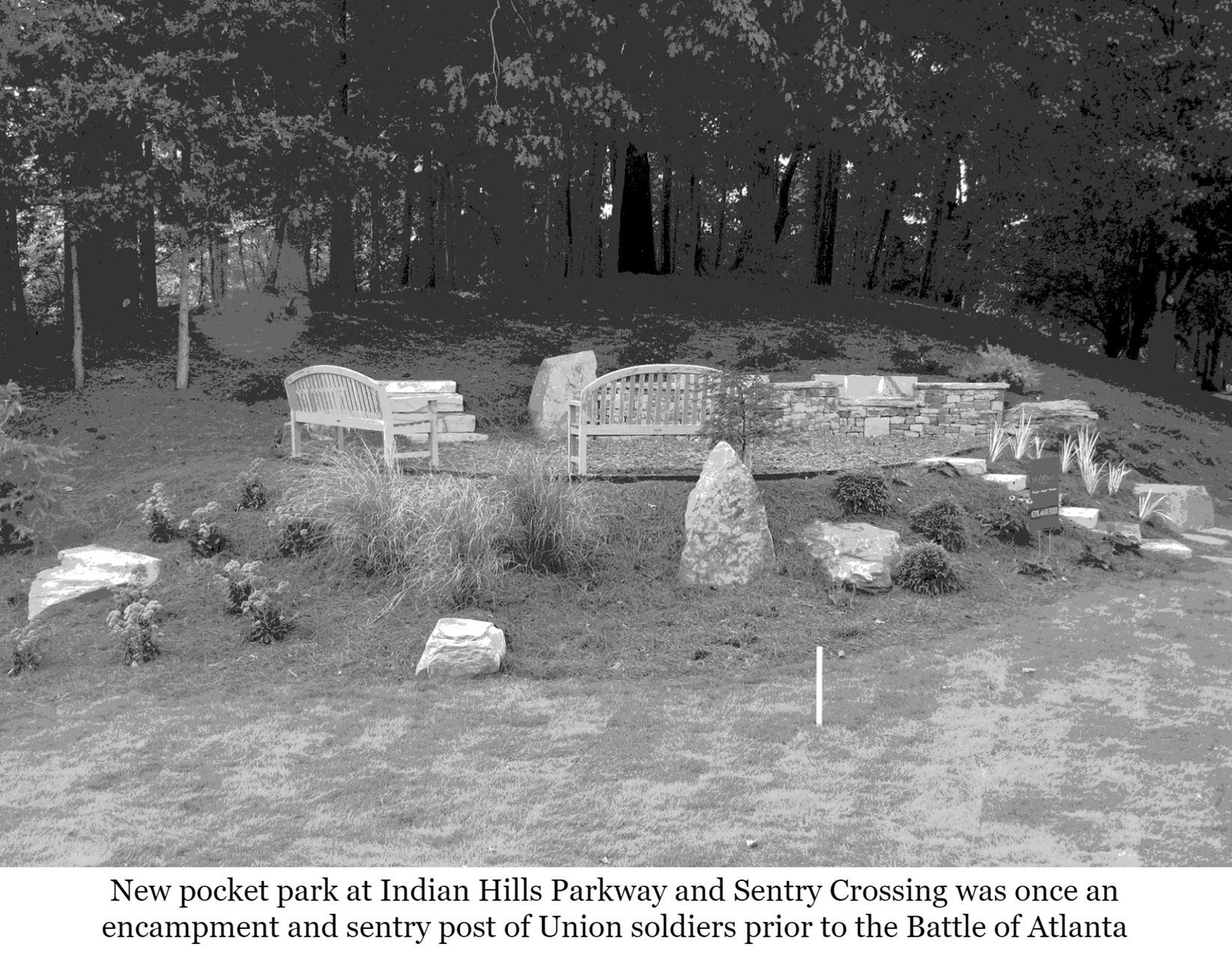 By the mid-1960s when developer Tom Cousins turned his sights on east Cobb County’s undeveloped farmland for his vision of a golf course community outside the perimeter, Atlanta’s population was booming. Court-ordered school busing now underway in the city of Atlanta helped fuel a growing market for suburban residential housing further into the northern suburbs.
By the mid-1960s when developer Tom Cousins turned his sights on east Cobb County’s undeveloped farmland for his vision of a golf course community outside the perimeter, Atlanta’s population was booming. Court-ordered school busing now underway in the city of Atlanta helped fuel a growing market for suburban residential housing further into the northern suburbs.
The completion of I-285, I-75 and I-85 made access to jobs in the city convenient. Jobs themselves were pushing further north with development of the Cumberland Mall and Perimeter Mall areas as beginning business nodes. Lockheed was a major employer. Many of our early residents were IBM, Lockheed and Monsanto Chemical managers and executives.
It was only at the beginning of the decade that Marietta had been added to metro Atlanta’s telephone calling area, a sure sign that this once rural farmland was gaining stature as part of the larger regional Atlanta metropolitan area. Urban sprawl was taking its first tentative steps across the Chattahoochee River. Tom Cousins, though dubious at first, was leading the charge.
By this time, Cousins, still in his 30s, was already the largest home builder in Georgia, according to an article in the Dec. 7, 2006, edition of the Atlanta Journal Constitution. That had mostly been in the Augusta area where Cousins got his start building prefabricated homes, said Hal Adams, an early Cousins team member who helped develop Indian Hills. Seeking a larger market, Cousins moved his operation to Atlanta, initially building apartments.
The distinction of being the largest home builder in the state didn’t take much, only 300 houses, Cousins was quoted as saying. Indian Hills alone would soon outstrip that number five fold.
Cousins went on to make his fortune in the 1970-1990s while building huge Atlanta developments such as the CNN building, the Omni Coliseum, and 191 Peachtree Tower. North Point Mall was built on his land.
But before he would change the Atlanta skyline, Cousins was planning Indian Hills on a grand scale, the first golf course community outside the perimeter that would become what many consider the heart of east Cobb. By 1968 Cousins was officially in the business of developing Indian Hills. The vision called for 1,000 single-family residential lots and 250 condo units on 1,150 acres. Some 350 additional acres would be added by 1973. More would come.

County records show an Affidavits of Business filed by Cousins Properties, Inc. in October of 1968 as “conducting a business on Gray Road (later renamed Indian Hills Parkway ) and Lower Roswell Road... under the name of Indian Hills Country Club. . .for the operation and management of a golf course and country club. Also, for Indian Hills subdivision “for real estate development, construction, operation and management.”
Phase I consisted of 532 acres.
A plat map filed with Cobb County June 13, 1969, shows the initial beginnings of the subdivision in Phase I. Indian Hills’ first entryway was off Lower Roswell Road onto Indian Hills Parkway. Lots were laid out along Fairgreen Drive and Fairgreen Lane. The Parkway extended as far as Adams’ house at 565 Indian Hills Parkway, he said. On the west side of the parkway, lots were laid out along Clubland Drive and Clubland Trail. No houses were to be built facing Lower Roswell Road, the map stipulated. Lots in Phase I sold for about $7,000.
Initially, one-acre lots were planned, but an economic downturn in the late 1960s threatened the fledgling project. Additional funds were needed to complete the clubhouse. Cousins’ financial partner, Ford Motor Credit, wasn’t confident enough that the experimental subdivision in what some viewed as the “the middle of nowhere” was viable enough to loan the money. That meant scaling back the overall lot sizes by 25 percent and cutting the size of the planned clubhouse in half to raise the needed capital, said Adams.
In the beginning Indian Hills was not a sure thing. “It was experimental. We were testing the market,” Adams said. According to Adams, he and Ben Selman, another Cousins point man on the Indian Hills project, convinced Cousins it was a risk worth taking. Adams said he had first spied the acreage from his plane which he flew out of the airfield at what is now Parkaire Landing at Johnson Ferry and Lower Roswell Roads.
The property, he said, wasn’t encumbered with rail- road tracks, rivers or other natural barriers. It was wide open for development as a mammoth subdivision, with much more potential than a proposed upscale project Cousins had directed he and Selman to explore in the Nancy Creek area off I-75. “That may have been a 200 or 300-house project, but we convinced Cousins that the Indian Hills land could be three or four times that size,” said Adams.
At first Cousins’ reservations that people were not ready to move to “the middle of nowhere” with no nearby shopping and limited road access seemed justified.
“Sales were kind of slow at first,” said Adams who was with Cousins from 1968 to 1971. Finding builders willing to come out this far was a challenge, he said. “We’d go out and find them and drive them out here. They’d ask, ‘Where are you taking me?’”
As lawsuits were filed over mandatory school desegregation in Atlanta and forced busing to balance racial enrollment became a reality, sales picked up. “That really kicked it off,” said Adams.
“One Saturday in November or December of 1969 we had so many people lined up there were traffic cops on Lower Roswell Road. Ninety percent of them were from Fulton County. We had a girl go out there and look at the car tags. At times, people were signing contracts on each other’s backs,” he said.
As Phase I filled up, Phase II quickly followed a year later. An April 14, 1970, plat map shows more lots under development along Indian Hills Parkway from Fairgreen Drive to Clubland Drive. This would include Clubview Terrace, Pine Point Trace, Sentry Walk, Sentry Crossing , two lots west on High Green Drive and two lots west on Clubland Drive.
Some unique marketing strategies helped boost sales in that area. Borrowing from a marketing strategy Cousins had employed in apartment development, another area of 50 to 60 lots near the golf course on and off Indian Hills Drive were set aside for special marketing to buyers looking for a quiet area without children. Many large ranch style homes in the area along Indian Hills Drive, Redding Trace and Weather- field Terrace appealed to retirees.
Real estate sales and marketing was handled by Sonny Bonner, president of Bonner Real Estate Co., out of a small building on the west corner of Indian Hills Parkway and Lower Roswell Road.
Water and sewerage treatment were critical to the subdivision’s growth. Cousins initially built a temporary sewerage treatment facility to serve Indian Hills until county pipelines could be extended to east Cobb, according to Selman. The temporary sewerage facility was built at the lowest point in the subdivision in a meadow near the banks of Sope Creek off Indian Hills Drive. The location is now just off the fifth hole of Cherokee, Adams said. It was never intended to serve the entire subdivision but would suffice until the county could reach the area with water and sewerage lines. It was operational for about two years.
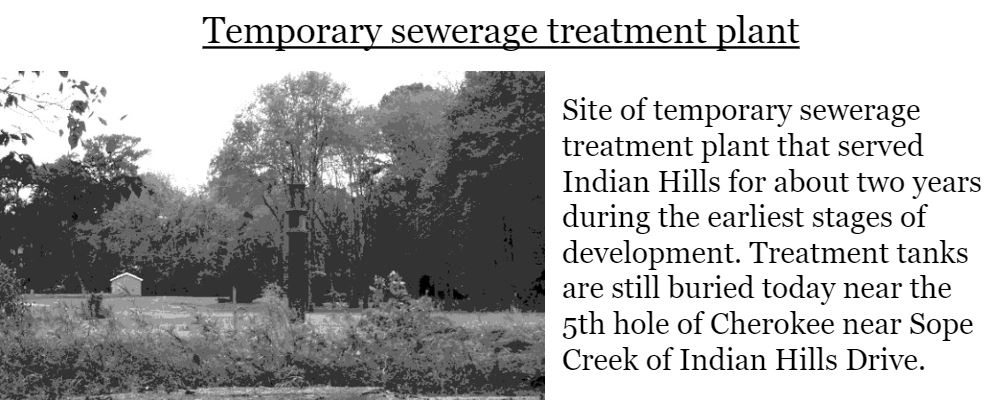
The sewerage was treated, dried and collected about every five or six weeks. It was added to the soil on the golf course as a fertilizer, said Adams. Today the old treatment tanks are still buried under ground at that site, he said.
The first county sewer line followed Sope Creek and the low-lying golf course. A vent shaft that allows steam to escape from the pipeline can be seen near the second hole of Cherokee golf course off Greenfield Drive. Excavation dirt from the pipeline was used to raise the golf course’s second green, Adams said.
Development along the northern portion of Indian Hills Parkway was held up as the county wanted to bring the second line in off Ga. 120 (Upper Roswell Road) and expensive pumping facilities were needed, Adams recalled.
Adams credits former Cobb Commission Chairman Ernest Barrett’s foresight in applying for newly avail- able federal money to local governments for growth stimulus for setting the stage in the 1960s. The money was to be used to build infrastructure such as sewerage treatment plants. And Barrett built them.
A 65-foot diameter pipeline connecting Fulton County’s Big Creek wastewater treatment plant on Ga. 120 in Roswell with south Cobb’s R. L. Sutton plant lies buried 200 to 250 feet beneath Indian Hills subdivision, Adams said.
“It was very controversial at the time. People were afraid it might collapse or blow up.”
Housing pushed further west along Clubland Drive in Phase III taking in Clubwood Trail, Clubwood Court, Ridgewater Drive and Clubland Terrace on the west side of Clubland by October 1970.
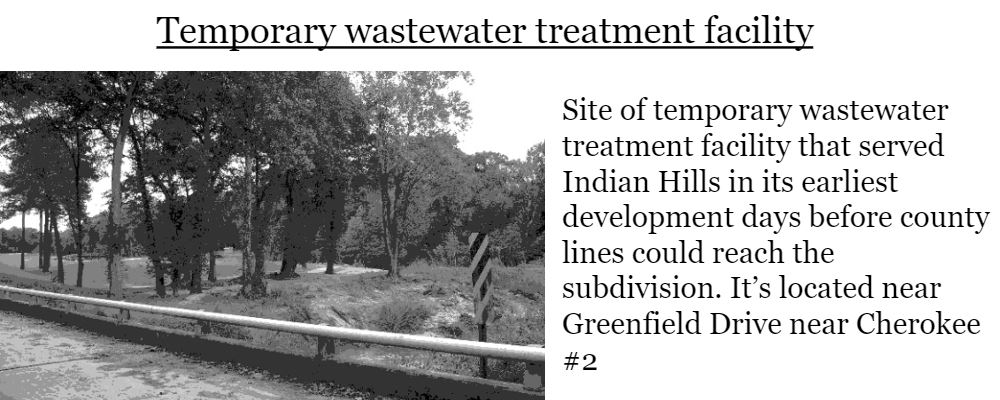
Indian Hills was growing, attracting young families with children in need of more classroom space, a gymnasium and additional facilities at East Side Elementary. In 1971, Indian Hills Properties, Ltd., and Indian Hills, Inc. sold a tract of land (approximately 15 acres estimates Adams) on the Roswell-Marietta Highway (Ga. 120) and Indian Hills Parkway to the Cobb County Board of Education for $10.
Adams said this was land behind and to the west of the school, allowing the campus to grow with the addition of a gym and more classroom space. The original design of Clubland Drive behind the school was shifted, allowing only one row of houses facing it. It had originally been laid out further north, closer to the current school, with houses to be built on both sides of it.
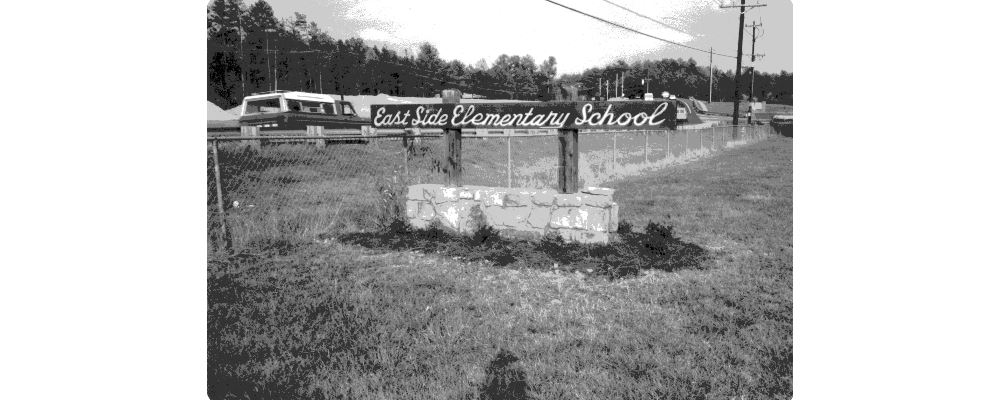
East Side Elementary had opened 19 years earlier, in 1952, replacing a two-room schoolhouse known as Mt. Bethel School at the northwest intersection of Lower Roswell and Johnson Ferry Roads. On opening, East Side was housed in a single building of 10 classrooms, according to a history provided by the school.
According to the school’s account, two classrooms were added in 1957, four in 1962 and four more in1965, in addition to a new wing of 11 classrooms a kitchen and cafeteria.
The old cafeteria and kitchen were remodeled to be- come the media center. A modular hall of six class- rooms added in 1986 further expanded the school. In 1975, some 1100 students were enrolled. The opening of Murdock Elementary in 1975-76 relieved enrollment pressures that had spilled over into portable classrooms at East Side. Enrollment dropped to 800 with the opening of Murdock.
According to the school’s history, for six months in 1978-79, East Side and Murdock shared the same facilities awaiting the opening of Mt. Bethel Elementary.
The community around the school was growing with more subdivisions springing up. Indian Hills continued to expand. By 1972, the subdivision was ready for its next growth spurt taking in Fairfield Drive and Fielding Way.
In that year, Cousins acquired 300 additional acres adjacent to the original development and built a third nine-hole golf course and developed 350 residential lots.
It was on its way in the 1970s and 1980s to mega subdivision status. By 1975, the subdivision included Indian Hills Townhouses, Phase I, taking in Argonne Place, Audubon Drive and Pritchard Place.
West of the parkway, a large tract came under the Indian Hills umbrella including Creek Stone Way, Stone Edge Court, High Green Drive, Creek Stone Court, and High Green Point. Clubland Drive was extended past Creek Stone Way.
The next growth spurt by 1979 encompassed Indian Hills Trail, Creekview Drive, Timberwood Terrace, Brookcliff Trace, Winding Creek Court and Rock- wood Court.
Fawn Ridge, Fawn Way and some lots facing Audubon Drive came in 1982 along with “The Muirfields,” formerly Pinecrest II. That included Muirfield Lane, Muirfield Trace, Muirfield Trail, Muirfield Ridge, Audubon Drive, and Muirfield Drive. Eight more lots on Fairfield extending east from Indian Hills Parkway became part of the subdivision in 1983.
Then as now, the centerpiece of the development was the Indian Hills Country Club and golf course, designed by noted golf course architect Joe Lee. Lee designed the initial 18-hole course which opened for play in the fall of 1969. Today the 243-acre golf course has grown to 27 holes and includes a driving range, practice putting green and chipping green. Among the country club’s amenities are eight tennis courts and three swimming pools. At first, country club membership came with the sale of a home.
In 1975 ownership of Indian Hills Country Club was sold to a bank lender. Jim Rhoden formed a limited partnership of investors to purchase the Club. In 1978, the Club was purchased by a local private Club management company headed by Rhoden.
Indian Hills was a master planned community. Cous- ins enlisted experts such as architect Hans Woldrich of Austria to carry out his vision. Woldrich “mixed and matched houses – ranches, split levels and two- story traditionals so their roof lines blended together,” recalled Selman. Winding roads and the subdivisions’ original covenants calling for earth toned colors for the houses added to the harmony of the community with its natural setting. It was a popular look of the era.
Brick houses weren’t allowed initially, said Adams. Woldrich personally approved builders’ designs and saw to it that lots were appropriately landscaped. “Some developers got their backs up at a six and a half foot-tall ‘Swede’ telling them what they could and couldn’t do,” recalls Adams.
The subdivisions original covenants have since expired.
Indian Hills Parkway was curved to skirt the Bishop family cemetery, at the corner of Indian Hills Parkway and Sentry Crossing.
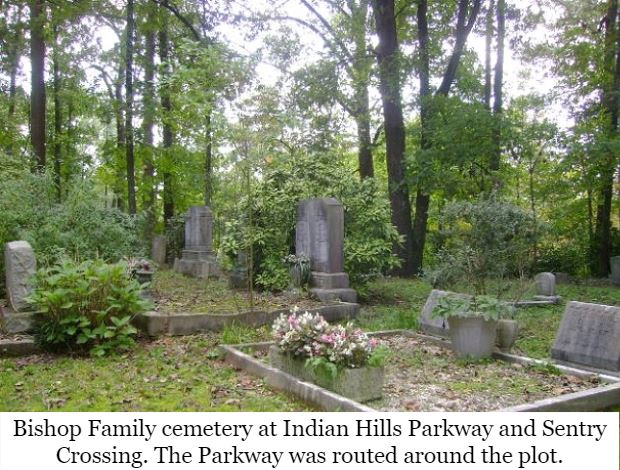
Sentry Crossing takes its name from the Civil War era. As Union troops drew nearer to capturing Atlanta in 1864, a group encamped there as a sentry outpost as they scouted a likely Chattahoochee River crossing point at Johnson Ferry, said Selman. The Cherokee golf course takes its name the tribe which once lived on, cultivated and hunted the land before being forced to Oklahoma on the “Trail of Tears.” Geography inspired many names such as Fairfield, and features such as the clubhouse. The girls in Cousins offices came up with many of the street names, said Adams.
Today, Indian Hills is home to an estimated 5,500 residents. “What we built,” said Adams, “is a small city.”
